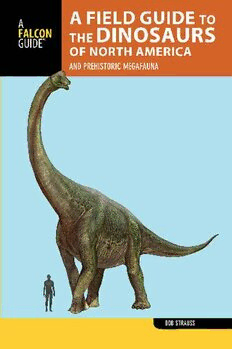
A Field Guide to the Dinosaurs of North America: And Prehistoric Megafauna PDF
Preview A Field Guide to the Dinosaurs of North America: And Prehistoric Megafauna
A Field Guide to the Dinosaurs of North America A Field Guide to the Dinosaurs of North America and Prehistoric Megafauna Bob Strauss Illustrations by Sergey Krasovskiy FALCONGGUUIIDDEESS® An imprint of Rowman & Littlefield Falcon, FalconGuides, and Outfit Your Mind are registered trademarks of Rowman & Littlefield. Distributed by NATIONAL BOOK NETWORK Copyright © 2015 Rowman & Littlefield All rights reserved. No part of this book may be reproduced in any form or by any electronic or mechanical means, including information storage and retrieval systems, without written permission from the publisher, except by a reviewer who may quote passages in a review. British Library Cataloguing in Publication Information Available Library of Congress Cataloging- in- Publication Data Strauss, Bob, 1961– A field guide to the dinosaurs of North America and prehistoric megafauna / Bob Strauss ; illustrations by Sergey Krasovskiy. pages cm. — (Falcon pocket guide) Audience: Ages 5–50. Includes bibliographical references. ISBN 978-1-4930-0925-1 (hardcopy) — ISBN 978-1-4930-1508-5 (ebook) 1. Dinosaurs—North America. 2. Dinosaurs—North America—Juvenile literature. 3. Dinosaurs—Museums—North America—Directories. I. Title. II. Title: Dinosaurs of North America and prehistoric megafauna. QE861.9.N67S77 2015 567.9097—dc23 2015012789 The paper used in this publication meets the minimum requirements of American National Standard for Information Sciences—Permanence of Paper for Printed Library Materials, ANSI/NISO Z39.48-1992. Contents Before You Head into the Field 1 Acrocanthosaurus 42 Agujaceratops 45 Albertosaurus 48 Allosaurus 51 Anchisaurus 54 Ankylosaurus 57 Apatosaurus 60 Appalachiosaurus 63 Bambiraptor 66 Bistahieversor 69 Brachiosaurus 72 Camarasaurus 75 Camptosaurus 78 Castoroides (Giant Beaver) 81 Centrosaurus 84 Chasmosaurus 87 Chirostenotes 90 Coahuilaceratops 92 Coelophysis 95 Deinonychus 97 Dilophosaurus 99 Dimetrodon 102 Diplodocus 105 Dire Wolf 108 Edmontosaurus 111 Euoplocephalus 113 Hadrosaurus 116 Hyracotherium 119 Kronosaurus 122 Lambeosaurus 125 Maiasaura 128 Medusaceratops 131 Megalonyx 134 Megapnosaurus 137 Nanotyrannus 139 Nothronychus 142 Ojoceratops 145 Ophthalmosaurus 148 Ornithomimus 151 Pachycephalosaurus 154 Pachyrhinosaurus 157 Parasaurolophus 160 Pentaceratops 163 Platypterygius 165 Plotosaurus 168 Postosuchus 170 Prognathodon 173 Pteranodon 176 Quetzalcoatlus 179 Sauroposeidon 181 vi Contents Shonisaurus 184 Smilodon 187 Stegoceras 190 Stegosaurus 193 Styracosaurus 196 Triceratops 199 Troodon 202 Tyrannosaurus Rex 205 Utahraptor 209 Woolly Mammoth 212 About the Author 215 About the Illustrator 216 Contents vii Before You Head into the Field Setting the Scene Let’s take a pretend trip back about 65 million to 250 million years ago to the Mesozoic era, when trillions of dinosaurs roamed the expanse of what we now call North America. Not only trillions of dinosaurs, but trillions of each kind of dinosaur: meat- eating tyrannosaurs, feathered raptors, horned, frilled ceratopsians—you name it. To put the number into perspective: Only about one hundred billion human beings have ever been born, and that’s counting back to an arbitrary starting point of fifty thousand years ago. Raise that number by the vast expanse of deep geologic time and you’ll get a sense of how impressive the dinosaurs’ two- hundred- million- year dominance really was. Of course, peek in at any given time in North America’s past and you’ll see that not all dinosaurs were equally represented. Some were naturally more populous than others (during the late Jurassic period, for instance, plant- eating ornithopods like Camptosaurus vastly outnumbered meat- eating theropods like Allosaurus, for the same reason that there are a lot more wildebeests in Africa today than there are big cats—it takes a large population of herbivorous animals to support a smaller population of meat- eating ones). Take any slice through deep geologic time, in any region of North America, and you’ll find a unique ecosystem: sauropods and hadrosaurs munching on different types of vegetation; small, feathered “dino- birds” 1
